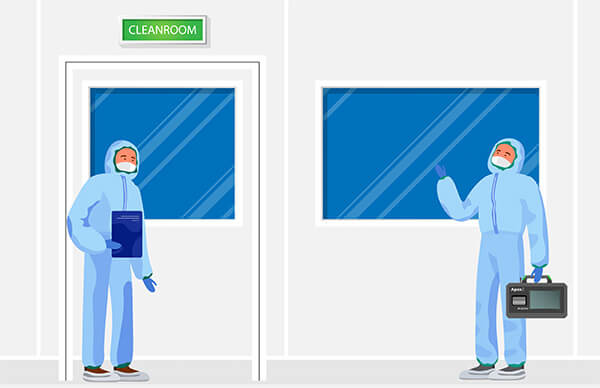If you’re working for a company already using a cleanroom, you’re well aware of the benefits of a cleanroom and how important they are. But if you’re wondering how you can improve your production, then a cleanroom might be the answer.
Either way, a cleanroom is not a simple beast. It is a multi-layered room that needs to be constantly monitored and maintained. Having a basic understanding of the fundamentals of what a cleanroom is will change the way you interact with your cleanroom.
What Does A Cleanroom Do?
A cleanroom does just that: it keeps things clean. They are used in several industries where particles in the air can impact the outcome of a physical product.
Essentially, a cleanroom is a highly sterilized environment where air must pass through a filter to enter the area. The main contaminant is the humans who enter and exit the room. But, other than that, the filter keeps small particles out of the room, which is constructed out of smooth, antistatic materials.
Who Uses A Cleanroom?
Cleanrooms are used by technicians and manufacturers in production in numerous industries. Some of the most common industries include:
- Electronics
- Pharmaceuticals
- Biotechnology
- Life sciences
- Food manufacturing
- Automotive
All these industries require strict monitoring of environmental factors during production. These environmental factors include pressure, temperature, and particle saturation of the air in the room – all of which can be monitored and controlled in a cleanroom.
 How Are Cleanrooms Classified?
How Are Cleanrooms Classified?
A cleanroom is classified depending on how clean the air is (or needs to be). To classify a cleanroom, you would use a particle counter to take a sampling of the air and examine how many particles are found. This is considered the known sample of the room. The cleaner the air (i.e. the lower the particle concentration), the higher the classification of the cleanroom.
There are two main ways to classify cleanrooms.
In the USA, cleanrooms can be classified using the Federal Standard 209 (FS 209). There are several classifications labeled FS 209A through FS 209E. This standard was established in 1963 by the Institute of Environmental Sciences and Technology (IEST). Most recently, FS 209E established the maximum number of particles to be counted as a cleanroom.
As for international standards, another way to classify cleanrooms is through ISO 14644-1. This standard was established in 1999. ISO is an independent organization dedicated to establishing international standards of best practice.
Ultimately, FS 209 E (the US standard) and ISO 14644-1 (the international standard) reflect the same measurements to classify a cleanroom at certain levels.
 Classifications Of Cleanrooms
Classifications Of Cleanrooms
There are 9 ISO classifications of cleanrooms:
- ISO 1
- ISO 2
- ISO 3 (FS 209 E class 1 equivalent)
- ISO 4 (FS 209 E class 10 equivalent)
- ISO 5 (FS 209 E class 100 equivalent)
- ISO 6 (FS 209 E class 1,000 equivalent)
- ISO 7 (FS 209 E class 10,000 equivalent)
- ISO 8 (FS 209 E class 100,000 equivalent)
- ISO 9 (room air)
ISO 1 is considered the cleanest possible room, with a known sample having 10 or fewer particles measuring .01 microns and 2 or fewer particles measuring 0.2 microns.
ISO 9 is normal room air, with a known sample having 35,200,000 or fewer particles measuring 0.5 microns, 8,320,000 or fewer particles measuring 1 micron, and 293,000 or fewer particles measuring 5 microns.
See Figure 1 for a full graph depicting the micron necessities for each classification.
 What Are The Components Of A Cleanroom?
What Are The Components Of A Cleanroom?
There are four zones in a cleanroom: the outdoor environment, ancillary areas, surrounding cleanrooms, and interior clean zones.
Humans and products to be worked on come from the outdoor environment. The work is done in the interior clean zones. But each zone (aside from the outdoor environment) should be monitored for its level of particulates.
 Interior Components Of A Cleanroom
Interior Components Of A Cleanroom
The heart of the cleanroom is the Air Handling Unit (AHU). AHUs contains a centrifugal fan – which is a fan designed to pull in air and change its direction. Cleanrooms use a lot of air and it is continually being circulated and filtered to maintain peak cleanliness, so these fans are critical to the success of the room. The size of the fan depends on the size and air needs of each specific room.
The AHUs also contain the filters used to clean the air. The air goes through several filtration stages. Typically, AHUs use High Efficiency Particulate Air (HEPA) filters, which has a 99.97% efficiency rate at the most penetrable particle size, 0.3 microns. They are made of glass fiber, which is interlaced for maximum efficiency. In some instances, an Ultra-Low Particulate (ULPA) filter may also be used. These filters catch particles that are 0.12 microns. These are most often found in cleanrooms where semiconductors are produced.
Air also passes through a cooling coil in the AHU to dehumidify it. A cooling coil could be either direct expansion (DX) or chilled water (CW) depending on the design of the AHU. Direct expansion coils use refrigerant to dehumidify and cool the treated air, whereas chilled water coils use water and fins to dehumidify and cool the air.
 Does Your Business Need A Cleanroom?
Does Your Business Need A Cleanroom?
If you’re reading this, your business may already use a cleanroom and you’re trying to understand them better or you might suspect that your business could benefit from a cleanroom.
So ask yourself these following questions to decide if a cleanroom is right for your business:
- Does your business produce micro-level goods?
- Does your business produce food?
- Does your business partake in scientific research?
- Do your products continually malfunction due to hardware issues from particles interacting with the product?
If you answered yes to any of the above questions, then your business could benefit from a cleanroom. While they are an investment and take careful monitoring, they can ultimately benefit your production immensely.
And you want to make sure you are caring for your investment and making the most of it. As one of the leaders in cleanroom monitoring solutions, we want to make sure your cleanroom is working harder for you than you are for it.
Want to make sure your cleanroom is at its peak performance? Contact us today.



